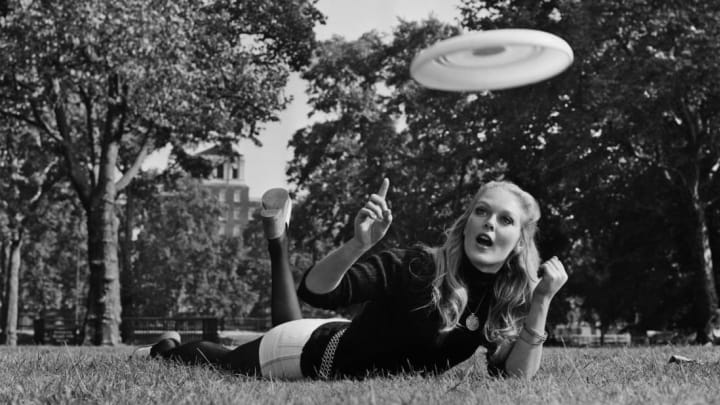Back in 1937, 17-year-old Fred Morrison and his girlfriend, Lucile Nay, were keeping themselves entertained during a family picnic by throwing the lid to a popcorn tin back and forth. They had such a blast that they started experimenting with other options to see if they could improve upon their game. Morrison raided his mom’s stash of pie tins and discovered that they held up much better than the flimsy popcorn lid. It was this disc the duo was tossing around on a beach when a spectator observed how much fun they were having; he offered them a quarter for their pie tin. The tin had only cost a nickel brand new, so Morrison readily agreed and began selling Flyin’ Cake Pans on California beaches shortly thereafter.
Fast forward 10 years. Through his tenure as a fighter-bomber pilot in WWII, Morrison continued to think about improving the design of the flying discs he and Nay (now his wife) had loved so much. He tinkered with it until he developed a model the flew better because of its sloped edge, which is still known today as Morrison’s slope. Trying to capitalize on the UFO craze, he stamped the names of the planets around the edge of the disc and started calling the toy the Pluto Platter.
Flying discs 101

You wouldn’t think flying discs require much explanation, but those early models had instructions printed on the underside, just in case people didn’t know how to handle the toy: “Play catch. Invent games. To fly, flip away backhand. Flat flip flies straight. Tilted flip curves. Experiment!”
By 1957, Morrison had racked up enough Pluto Platter sales to attract the attention of fledgling toy company Wham-O. After buying the rights, Wham-O rebranded the disc “Frisbee” after the Frisbie Pie Company. You see, students at Yale had picked up on the idea of tossing a tin back and forth and were using the local company’s pie receptacles in their games. In fact, it may have been the Yalies who put the Frisbie Pie Company out of business—when they started using pie tins for sport, the company complained that they had suffered a loss of at least 5000 reusable pie plates. Frisbie closed its doors shortly after the Frisbee discs came out in 1958, but as you’ve probably noticed, Frisbees are still going strong. (And in 2016, Connecticut's Dan O'Connor—a Frisbee aficionado, historian, and pie lover—relaunched the Frisbie Pie Company using its original recipes.)
Since then, Wham-O has sold somewhere in the neighborhood of 300 million discs—not too shabby for a pastime invented from an empty dessert plate.
A version of this story ran in 2011; it has been updated for 2022.
